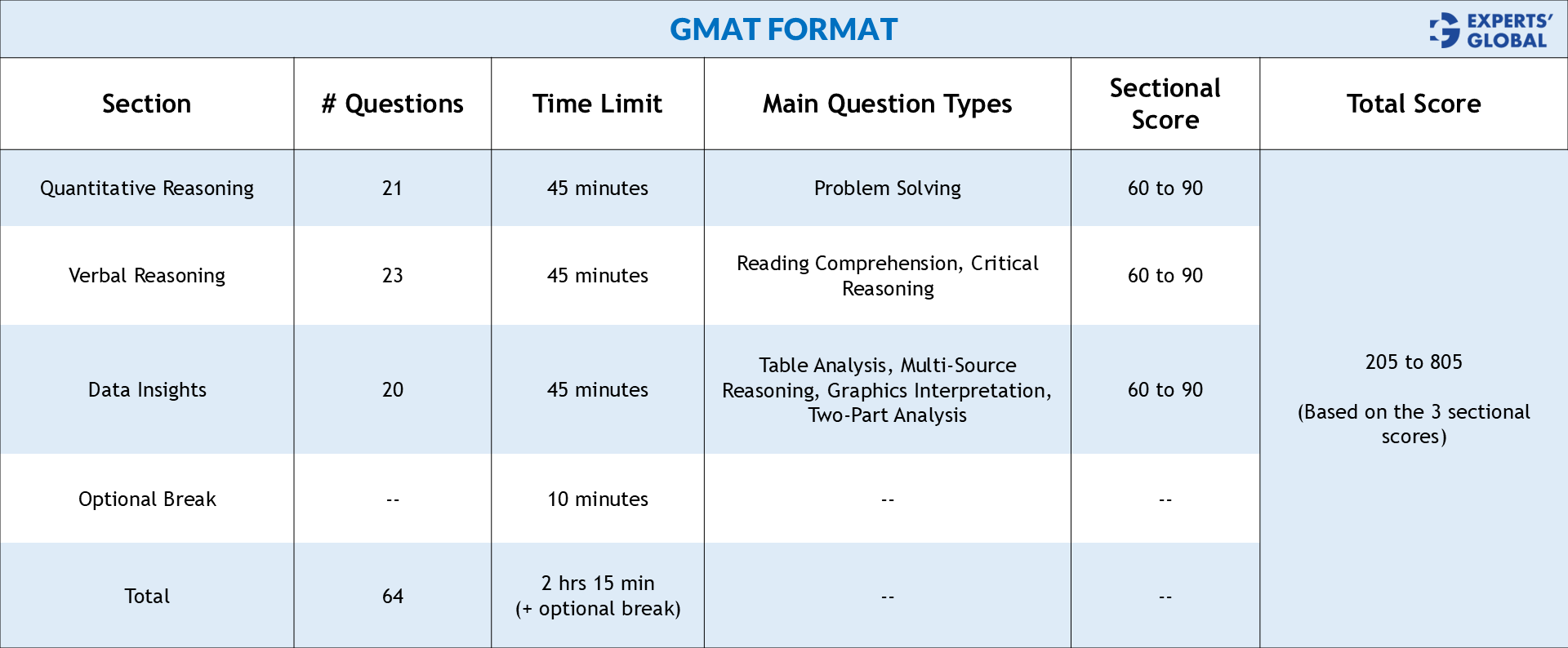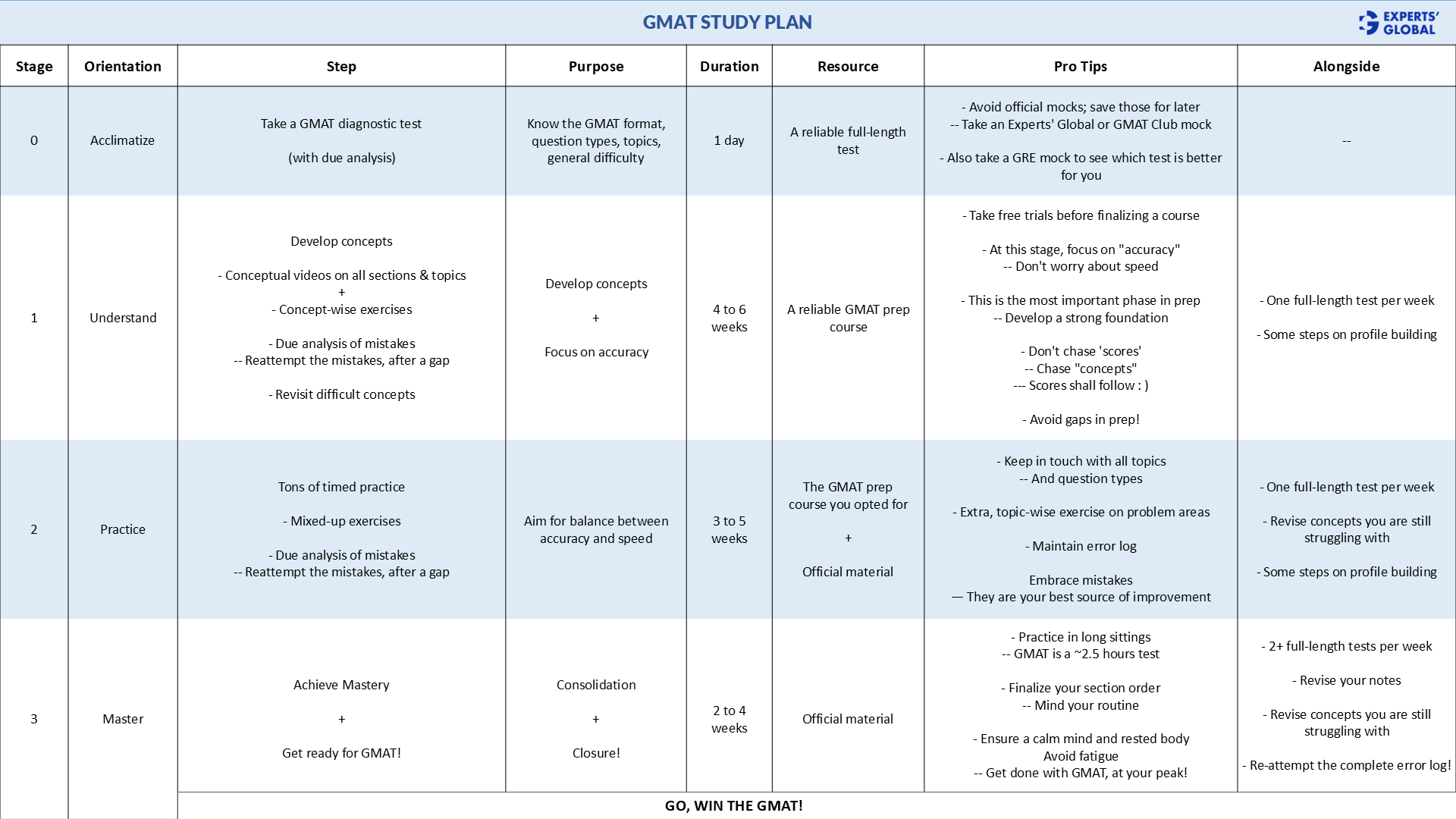Invest 30 seconds...
...for what may lead to a life altering association!
Help Line
- +91.8800.2828.00 (IND)
- 1030-1830 Hrs IST, Mon-Sat
- support@expertsglobal.com
...for what may lead to a life altering association!


Soon after learning the GMAT format, timing, question types, and test interface, take a GMAT diagnostic test under official conditions. A few hours of familiarization are enough. Take the first GMAT mock test within your first week to set a genuine, honest, reliable starting score.
With the short answer clear, let us now explore the complete picture…
Just a few hours are enough to understand the GMAT. You do not need weeks before your first practice. Spend a focused evening learning the test’s sections, timing, question types, calculator rules, and break structure. Skim official directions and take a short user interface tour. Do a handful of sample questions only to get a general idea of the question types and to understand screen flow and tools. The first practice test should be to fully experience the GMAT and to know your baseline score for planning your GMAT prep; hence, do not overprepare for the diagnostic test. The goal is comfort with mechanics, not mastery of content. This light warm-up lets your diagnostic reflect reasoning, pacing, and test stamina, rather than confusion about buttons or instructions. With this small step, your first score becomes useful guidance instead of confusion.
A diagnostic test should capture your true starting point. If you take it without first learning the test format, sections, question types, timing, and on-screen tools, your score will drop for reasons that have little to do with your skill. Lack of awareness can slow you down, create avoidable errors, and blur what the result really means. The goal is to separate unfamiliarity from ability, so the baseline you set is honest and useful. Therefore, spend some time in getting familiar with how the test works, how questions are framed, how timing feels, and how features such as flag and return work. Then take the first full-length mock in the GMAT test series under official exam-like setting. This way, you will earn a truer baseline score and a clearer plan for growth.

Early data prevents guesswork. A diagnostic within the first week shows your current level, how timing feels across sections, and where misunderstandings sit. It also protects you from spending months on low-leverage areas. The first number is not a label. It is a starting point that turns hopes into a plan. When you see patterns early, you can choose the right mix of concept study, practice sets, and pacing drills. An early baseline also reduces unnecessary anxiety later because you will watch trends form over time, not hinge your plans on a single, late score.
The official GMAT mock tests use retired GMAT questions and the original scoring algorithm, making them the most authentic measure of performance. However, they are limited in number and do not provide detailed analytics or detailed explanations. Their best use is when you are closer to the actual test. Therefore, while it is perfectly fine to take an official mock as your diagnostic, it is often wiser to save the official tests for later and use a reliable, high-quality third-party GMAT mock as your diagnostic to set your baseline score. Please, however, ensure that the third-party mock you use comes from a trustworthy source and is a true full-length GMAT-like diagnostic test, as many third-party resources offer short quizzes and label them as diagnostic tests.
Treat your diagnostic as a dress rehearsal. Sit at a desk in a quiet room with a laptop or desktop (for correct experience, do not take the mock on mobile or tablet). Follow the exact section times and allowed breaks. Use only what is permitted for notes. Take the test in one continuous sitting with just the allowed break, at the same time of day you prefer for the real exam. Avoid pausing or checking answers.
Most high-quality GMAT diagnostic tests, including the official mock and the Experts’ Global’s free mock, allow you to flag questions for later review. While taking the test, flag every question you had to guess and every one you found difficult to solve. After completing the diagnostic, return to these flagged questions to review them carefully. This helps you identify lucky guesses that need conceptual reinforcement and questions that revealed real struggles. For such questions, use the provided explanations wisely to understand the concept and the most efficient solving method. Beyond a point in your preparation, most learning comes from analyzing your mistakes and struggles.
Remember, on the GMAT, penalty is steeper when you don’t complete the test; hence, ensure answering all questions even if that means making a few guesses toward the end of a section. Else, if you leave a few questions unanswered, you will face steep penalty and your resulting diagnostic score will not be reflective of your correct level. When stuck on a question, make an educated guess when stuck, flag the item, move on, and return only if time remains. Realistic settings produce honest results and a clearer next step.
A good GMAT diagnostic test generally comes with a detailed score report and insightful analytics. For example, the Experts’ Global GMAT Diagnostic Test gives you total and sectional scores with percentiles, clear insight into section-wise performance, question type-wise performance, topic-wise performance, time management, and concept-wise accuracy, plus your five weakest and five strongest areas in each of the three GMAT sections. Use all such data carefully to plan your GMAT preparation journey ahead.
Approach the results like a coach, not a critic. Separate issues into three buckets: knowledge gaps, process errors, and pacing choices. Knowledge gaps require concept study and targeted practice. Process errors need clearer step-by-step methods and better checks. Pacing choices demand a plan for when to invest time and when to move. Highlight a few high-leverage fixes rather than listing everything. A short list you will complete beats a long list you will ignore. The purpose of the diagnostic is to focus your effort, not to judge your potential.
You first familiarized yourself with the GMAT format and then took a full-length diagnostic test; these steps gave you a solid grounding in what the test demands. If you took an Experts’ Global GMAT mock as your diagnostic, your score report provides total and sectional scores with percentiles, question type-wise and topic-wise performance, time management insights, concept-wise accuracy, and your five weakest and five strongest areas in each GMAT section. At this stage, plan your preparation by aligning study time with your target application deadlines and target score. Balance weekday and weekend hours, and account for baseline strengths, preferred study style, access to resources or mentors, mock-test cadence, and work or family commitments. This clarity helps create a focused, realistic roadmap for steady progress.

If your diagnostic test score is lower than expected, do not feel disheartened. You are only beginning, and early progress is often steep. Once you become familiar with the test format, question styles, and core concepts, your score can rise sharply. On the other hand, if you performed better than you expected, stay grounded. Continuing to improve from a good score requires steady, patient effort. Either way, let your diagnostic score serve its true purpose: to establish a baseline and to help you begin your GMAT preparation in a structured and organized manner.
In the early stage, plan a full test every one to two weeks. Choose two weeks if fundamentals still feel uncertain. Shift to weekly once your study rhythm is in place. The space between tests is where improvement happens. Use it to fix patterns revealed by the diagnostic. Four to six weeks before the official exam, move to weekly tests, and add one lighter section session if review quality remains strong. Protect recovery time after each full test so that your next study block stays focused and fresh.
Creating accurate GMAT mock tests is a highly specialized task. From the quality and logic of questions to topic balance, scoring precision, and interface design, many complex elements must align to reflect the real GMAT. It is common knowledge that most free diagnostic tests available online fail to meet these standards and can give misleading results. Alongside the official GMAT practice tests, it is recommended to use only one well-designed third-party diagnostic tests from a trusted source. This focused, high-quality approach ensures dependable insights into your readiness and helps you plan your preparation with clarity and confidence.
Many GMAT aspirants lose valuable time navigating through free videos, scattered question banks, and endless discussion forums, only to find that their progress remains unclear. GMAT preparation is as much about structure and focus as it is about effort. In our experience, students who trust one high-quality GMAT preparation course and the official study material achieve the best results. Take your time to explore free trials and choose a course that truly fits your study style. Once you find the right one, commit fully and pair it with the official material. The path to a high GMAT score is not through collecting more resources, but through mastering the right ones with focus and discipline.
If you are at the start of your GMAT preparation and have not yet finalized which exam to pursue, it can be useful to take one of the GRE mock tests too. Doing so will help you see which exam feels more intuitive and aligns better with your natural test-taking rhythm. Since most business schools accept both GMAT and GRE scores, your decision should rest on which exam you believe will allow you to perform at your best after a fair comparison. You can take a free, full-length GRE diagnostic test through this page to experience its structure, timing, and question types directly, helping you decide which exam matches your strengths and preparation style more closely.
Your first practice test is more than a number. It is a mirror for habits. Plan with care, sit with discipline, and study with patience. The same cycle drives strong MBA applications: set a goal, gather honest data, refine your story, and execute with clarity. Leaders do not guess; they measure, learn, and act. Each practice becomes a rehearsal for decisions you will make in school and at work. Start early, review deeply, and improve one detail each week. You will carry this quiet method into essays, interviews, team projects, and careers, where steady progress creates meaningful outcomes and beyond.